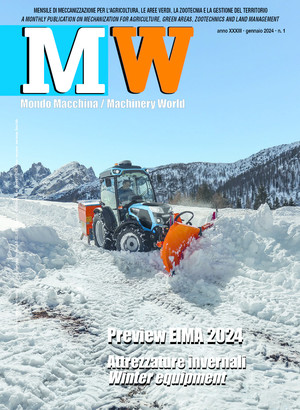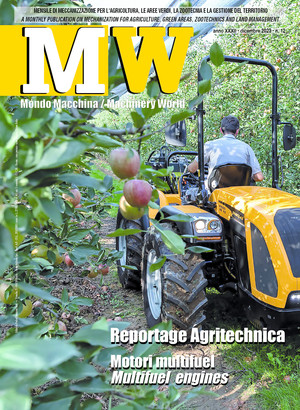
Water conservation, localized irrigation
In addition to ensuring substantial water savings compared to traditional methods, micro-irrigation allows you to better manage the frequency and duration of the operations. With subirrigation, better still if combined with the simultaneous distribution of fertilizer, even greater efficiency is achieved
Water is one of the key factors for agricultural production, probably the most important. This is a key asset, subject to renewed attention at the global level: the “waterfootprint” is an indicator of freshwater consumption in creating a product, which includes both direct and indirect use, and represents the total volume of freshwater used (incorporated, evaporated or polluted) in a given unit of time. This is therefore a paramount parameter for any agricultural product, for which it is necessary to optimize not only the absorption by the plant, but also the techniques and modes of distribution, in order to minimize the unavoidable losses (e.g. evaporation), and above all else, waste.
On the other hand, the irrigation technique is aimed at maintaining humidity levels in the soil so as to optimize the absorption by the plant’s root system in relation to its developmental stage.
Micro-irrigation
For open field crops, flow irrigation does not fit well with these goals. Sprinkler irrigation seems much more suitable, although in unfavourable situations (high temperatures and windy conditions) it can create some problems. However, for a long time now there has been a valid alternative solution: so-called “micro-irrigation”, where water is delivered drop by drop in small volumes, with close time intervals (to keep the soil humidity as constant as possible) and above all with infiltration localized only to the soil area reached by the roots.
This solution is certainly not new, having been tested and successfully refined in developed agriculture countries with an endemic water scarcity (e.g. Israel), and applied thus far especially for horticultural and floral crops, especially in protected plots. Modern technology has extended the application of localized irrigation also in the sectors of open field crops, vineyards and fruit orchards, often with the development of dedicated solutions. Drip irrigation typically involves low operating pressures (1-4 bar), with limited flow rates. Compared to traditional solutions, the savings in terms of energy, but above all water, is extremely tangible. In this way, it is also possible to draw efficiently from non-abundant withdrawal points, such as simple wells. In addition, the problem of wind is automatically resolved since water is not dispersed. There are interesting developments such as subirrigation (see box), which uses underground pipes, and fertigation, where water is combined with appropriate fertilizing elements, both of organic and mineral origin. Of course, this case involves some critical issues, first of all the cost not only of the material, but also of the laying and installation of the pipes and main components, as well as their removal when the plant has completed its work cycle. In addition, the pipes are typically small in diameter, so they can clog, just like the drippers. For this purpose it is necessary to provide an efficient physical filtration apparatus. In this regard, water quality is also important, especially in the presence of limestone and/or suspended solid particles, even worse if they are corrosive, which must be remedied by specific chemical treatments.
The main components
A localized irrigation plant is based on a network of pipes (usually PVC or polyethylene, materials that are flexible and resistant to physical and chemical stress) that transport water from the withdrawal point to the drip lines, or other pipes with smaller diameters than the main ones and complete with micro-emitters placed near the plants to be irrigated. The emitters, which are always plastic, come in different shapes and sizes: they range from simple calibrated holes applied to drip lines, from which water comes out in the form of a spray, to the “self-compensating” models, aimed at maintaining a constant flow rate at every point on the network.
If necessary, a pump is installed upstream of the plant, operated either electrically or by a small internal combustion motor, providing the necessary fluid pressure for proper operation. There is always a computerized control unit that, in addition to scheduling the volume and duration of the irrigation, can detect abnormal events and activate alerts and corrective actions. Obviously, the control unit can be implemented with appropriate sensors for the main environmental parameters, so as to provide an irrigation that is always optimized to the crop’s needs.
Turbulence as a solution to the problem of clogging
This is the most important aspect to be taken into consideration both in the design and in the maintenance of the plant, especially if using drainage water, or in any case with a suspended solid content higher than the norm.
A thorough upstream filtering is the main measure that is implemented. There are various types of filters suitable for different contexts: vortex separators are suitable for waters from rivers, lakes and wells with lots of sand, net and disks separators serve to capture small suspended solid and inorganic particles, while grit (quartzite) separators are good for waters with considerable amounts of algae, slime and lime particles.
In any case, the irrigation system’s lifetime is based on the efficiency of the emitters. A formidable step forward in this direction was determined by the appearance on the market of drippers inserted directly into the piping, of varying shape, but with a single purpose: to guide the flowing water along a tortuous path so as to give the fluid a high turbulence to avoid the formation of organic or inorganic sediments as much as possible, which would inevitably lead to progressive clogging and ultimately to the total or partial loss of the main function of the emitter. Self-compensating or not, there are different configurations of emitters, flat, cylindrical, continuous labyrinth, etc. are available, each suitable for certain situations.
The control units
From a generalized perspective of sustainability, localized irrigation provides the best if managed in full compliance with an appropriate system for monitoring crop conditions and weather parameters, to optimize the frequency, duration and intensity of the irrigation.
Netafim Italia of Monleone di Cicagna (GE) offers uManage, a decision support tool based on a network of detection stations equipped with numerous monitoring sensors detecting crop and soil status, as well as the main weather parameters, able to process the information needed to better manage the water resource.
uManage uses a browser that can be accessed via PCs, tablets and smartphones, with an interface that provides geo-referenced maps, to retrieve historical data and set personalized thresholds for action, alerting the user when a situation occurs that could potentially be damaging to their crop.
Laying and recovery
Appropriate equipment is available for installing the main and secondary pipes of a drop irrigation system, often mounted on the rear three-point hitch of the tractor. For subirrigation, the operation is more complex, since it involves burying the pipes to the desired depth. Subsoiling anchors are used for this purpose. These are fitted with shaped metal tubes which start at the top near the spools from which the pipes are to be unrolled, and below they end at the bottom of the tool. Starting from the excavation head, the anchors towed by the tractor penetrate into the ground and lay the tubes at the base of the trench that has been created.
Similarly, the recovery of the main pipes is mechanizable, exploiting the principle of the winch. In practice, the tractor mounts one or more large spools (with a pin that can be single or double truncated cone) that are rotated at a peripheral speed similar to the tractor’s forward speed, if this passes through the field. In this way, the drip line is pulled out of the ground and wraps itself, either freely or through mechanisms (including by hydraulic drive) that guides the correct positioning in order to optimizes how the spool is filled. For piping only laid on the ground and not buried, the operation can also be performed from a fixed point at the edge of the field. In any case, at the end, the pipe bundles are unrolled (even automatically) from the spools, tied and laid on the headlands for their subsequent reuse, or removed for disposal.
Subirrigation
Subirrigation, or more precisely “micro-irrigation with buried drip line” is a technique that enhances the many benefits of localized irrigation. In practice, the pressure drop system is placed below the ground level, usually between 10 and 40 cm, delivering water and any added nutrients.
Compared to other irrigation methods, subirrigation has several benefits such as: substantial water savings, due to the absence of evaporation and drift due to the wind; excellent absorption efficiency (including any fertilizer) due to the delivery very close to the root systems, with the additional benefit, in the latter case, of performing the action with the utmost timeliness and effectiveness, especially for elements that are not very mobile, such as phosphorus and potassium; low surface soil humidity, resulting in a reduction of fungal diseases and the development of weeds; possible injection of air to oxygenate the root systems; thanks to the burying, effective protection of the most sensitive components of the plant from the ageing action of ultraviolet rays and temperature fluctuations; reduction of the visual impact of the plant, ensuring the landscape aesthetic value of the crop, which is especially important for the specialized ones; in the case of parks and gardens, full access to the lawns, even when the watering is in progress; totally mechanizable installation and above all, no obstacle to performing other plant operations. The main problem observed in recent decades in the spread of this technique is due to the intrusion of root hairs into the drippers through their emission hole.
There have been several solutions adopted to avoid the danger of clogging: pipes with “lip” slots, which opened and closed using the hydraulic pressure, porous tubes, etc., but none of these has proved to be a winner.
Conversely, coextruded drip lines (with the drippers already integrated at the manufacturing stage) have proven very promising, by constituting an effective barrier to penetration of the roots.








